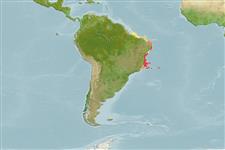Classification / Names
ຊື່ສາມັນ | ຄຳສັບຄ້າຍຄືກັນ | Catalog of Fishes(ຕະກຸນ, ຊະນິດ) | ITIS | CoL | WoRMS | Cloffa
>
Eupercaria/misc (Various families in series Eupercaria) >
Labridae (Wrasses) > Corinae
Etymology: Halichoeres: Greek, als, alis = salt + Greek, choiros = pig (Ref. 45335); rubrovirens: Name from Latin which means red and green; referring to the distinctive red and green color pattern of the adults.
Environment: milieu / climate zone / depth range / distribution range
ນິເວດວິທະຍາ
ສັດທະເລ ກ່ຽວກັນຫີນ; ລະດັບຄວາມເລິກ 6 - 25 m (Ref. 83981). Tropical
Southwest Atlantic: endemic to the Trindade and Martin Vaz Island group, located 1200 km east of the southeastern Brazilian coast.
ຂະໜາດ / ນ້ຳໜັກ / Age
Maturity: Lm ? range ? - ? cm
Max length : 23.1 cm SL ຕົວຜູ້/ບໍ່ມີເພດ; (Ref. 83981)
Little is known about the ecology for this species, however, juveniles seem to mimic and usually swim together with schools of Thalassoma noronhanum which they resemble in color. Specimens were observed over high rugosity rocky bottoms with calcareous algae at depths (Ref. 83981).
Life cycle and mating behavior
ການຈະເລີນເຕັມໄວ | ການສືບພັນ | ການວາງໄຂ່ | ໄຂ່ | ຄວາມດົກຂອງໄຂ່ປາ | ຕົວອ່ອນ
Distinct pairing during breeding (Ref. 205).
Rocha, L.A., H.T. Pinheiro and J.L. Gasparini, 2010. Description of Halichoeres rubrovirens, a new species of wrasse (labridae: perciformes) from the Trinidade and Martin Vaz Island group, southeastern Brazil, with a preliminary mtDNA molecular phylogeny of the New World Halichores. Zootaxa 2422:22-30. (Ref. 83981)
IUCN Red List Status (Ref. 130435: Version 2024-2)
Threat to humans
Harmless
Human uses
ເຄື່ອງມື
Special reports
Download XML
ແຫຼ່ງອີນເຕີເນັດ
Estimates based on models
Preferred temperature (Ref.
123201): 25.8 - 27.6, mean 27.4 °C (based on 113 cells).
Phylogenetic diversity index (Ref.
82804): PD
50 = 0.5000 [Uniqueness, from 0.5 = low to 2.0 = high].
Bayesian length-weight: a=0.00977 (0.00574 - 0.01664), b=3.09 (2.94 - 3.24), in cm total length, based on LWR estimates for this species & Genus-body shape (Ref.
93245).
ຊັ້ນເຂດຮ້ອນ (Ref.
69278): 3.6 ±0.5 se; based on size and trophs of closest relatives
ຄວາມຢືດຢຸ່ນ (Ref.
120179): ຂະໜາດກາງ, ປະຊາກອນຕຳ່ສຸດທີ່ໃຊ້ເວລາສອງເທົ່າ 1.4 - 4.4 ປີ (Preliminary K or Fecundity.).
Fishing Vulnerability (Ref.
59153): Low vulnerability (18 of 100).
